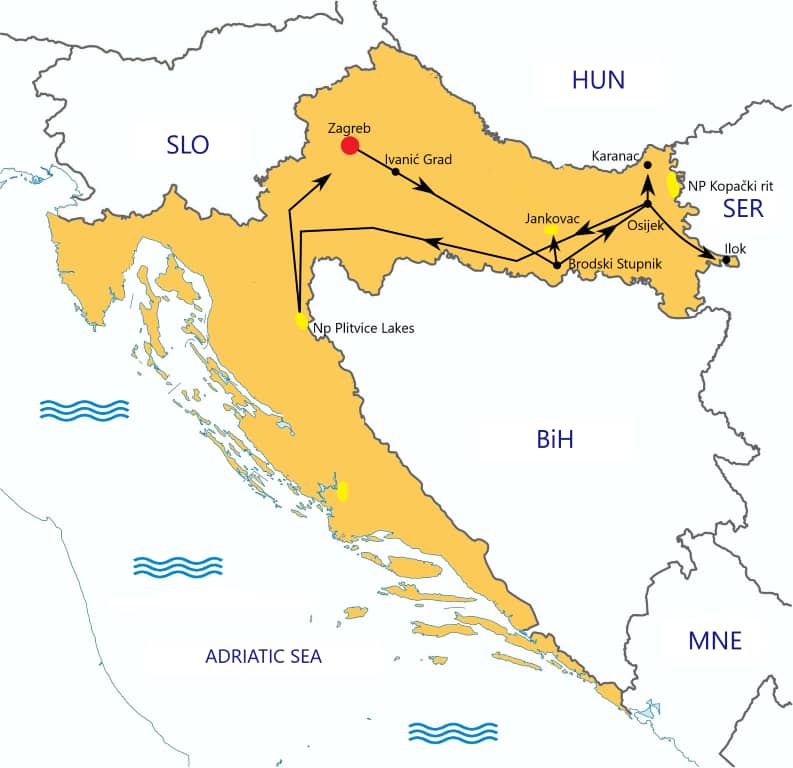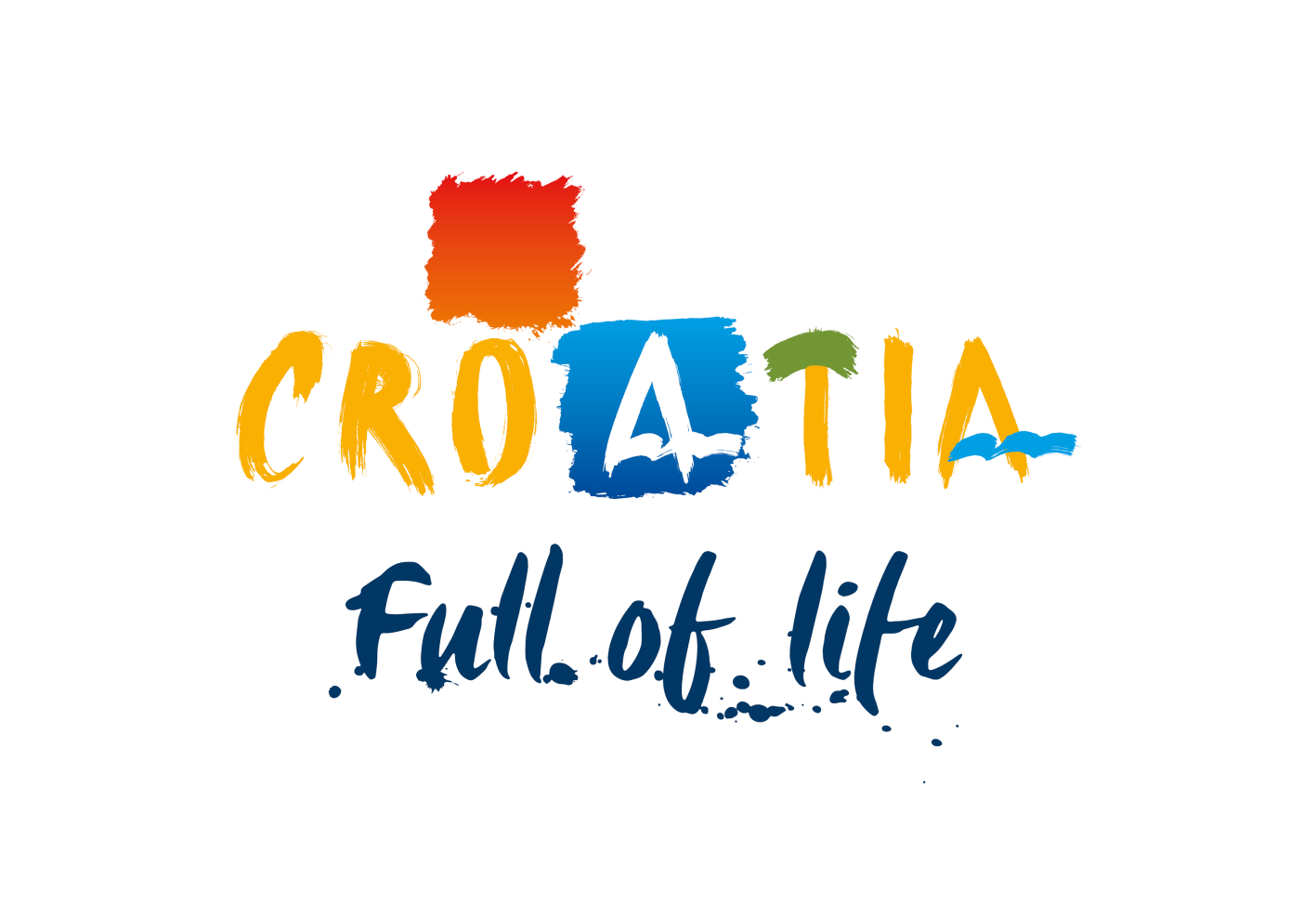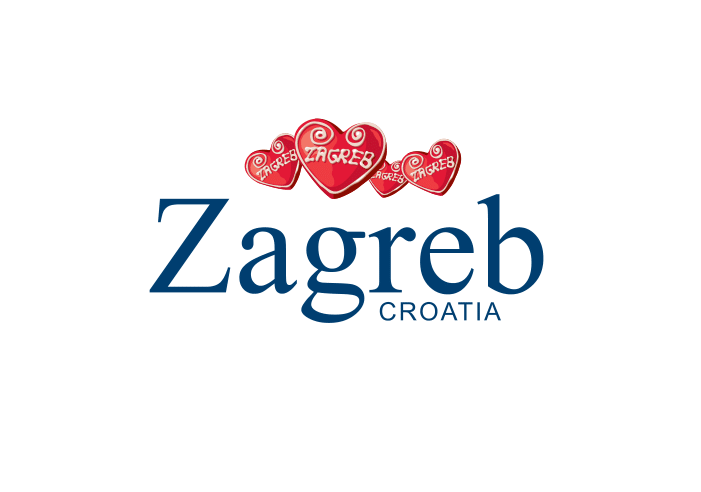CROATIA PHOTOGRAPHY TOUR
Croatia, Zagreb and surrounding, Zagreb
Duration
Transportation
Route

Itinerary
ZAGREB
Arrival in Zagreb. Check-in at the hotel. Lunch. Meeting with a professional photographer and short time for taking pictures. Dinner and overnight stay.
ZAGREB AND SURROUNDINGS
Breakfast. Driving through beautiful landscapes. Taking pictures of Eco village Žumberak and Biopark Wild water. Lunch. Taking pictures of Uskoks Museum in Žumberak, Stojdraga and the Sopot waterfall. Returning to the hotel. Dinner and overnight.
ZAGREB AND SURROUNDINGS
Breakfast. Forest Žutica in Ivanić Grad, the Church in Ivanić-Grad, Eco Village Kezele. At the end all the participants will be awarded diplomas. Returning to the hotel. Dinner in a Chinese restaurant. Overnight stay
ZAGREB AND SURROUNDINGS
Breakfast. Forest Žutica in Ivanić Grad, the Church in Ivanić-Grad, Eco Village Kezele. At the end all the participants will be awarded diplomas. Returning to the hotel. Dinner in a Chinese restaurant. Overnight stay
ZAGREB – BRODSKI STUPNIK
Breakfast. Transfer to Stupnički Dvori winery. Meeting with a professional photographer and and time for taking pictures. Visiting Višnjica farm and taking pictures of horses, old buildings and wild animals. Returning to the hotel. Dinner and overnight stay.
NATURE PARK PAPUK AND SURROUNDINGS
Breakfast. Visiting Jankovec - one of the most beautiful hill valleys located in the northern part of Papuk, on the elevation of 475 meters. It’s rich with cold sources of water and clear rivers, surrounded by the hundred year old beech forest. Taking pictures of 30 meters high waterfall. Lunch. Visiting vineyards and shooting. Then visiting Kutjevo winery and cellars, as well as taking pictures. Returning to the hotel. Dinner and overnight.
KOPAČKI RIT NATURE PARK - OSIJEK
Breakfast. Departing for Osijek. Visiting Kopački Rit, a nature park in eastern Croatia in municipalities of Bilje and Kneževi Vinogradi. It is located northwest of the confluence of the rivers Drava and the Danube. Renting a boat and taking pictures of animals and birds in particular. Taking off to Zlatna Greda. Canoe sailing and taking pictures of mammals, birds, reptiles, amphibians, fish and even insects. Returning to Osijek. Accommodation in the hotel. Dinner and overnight stay.
OSIJEK - ILOK - OSIJEK
Breakfast. Transfer to Ilok town. Taking pictures of the old core, Ilok winery and the old castle during the whole day. Transfer to Principovac estate and taking pictures of the vineyards. A panoramic elevator inside the castle leads to the glazed belvedere which offers an amazing view of the endless vineyards and the gentle slopes of Fruška Gora that descend towards the Danube. Returning to Osijek. Dinner and overnight stay.
OSIJEK - ETHNO VILLAGE KARANAC - OSIJEK
Breakfast. Departing for Ethno village Karanac. Ethno vil lage Karanac offers a possibility of taking pictures of old Pannonian house, a unique concrete road with three churches and the longest cherry tree-lined falls into the right category of ethno villages. Lunch in a local restaurant. Taking pictures of Ethno village Karanac. Returning to Osijek. Dinner and overnight stay.
OSIJEK
Breakfast. Taking pictures of the Old town in Osijek and its cathedral. Lunch. Visiting a gallery where will be posted your pictures of the last 5 days of the trip. The proclamation of the first, the second and the third places, as well as awarding the participants with diplomas. Dinner and overnight stay.
OSIJEK – PLITVICE LAKES
Breakfast. Transfer to Plitvice Lakes. Taking pictures of beautiful nature of Plitvice Lakes - 16 small and large crystal blue lakes. The lakes get water from numerous rivers and streams connected by cascades and waterfalls. Travertine barriers that appeared over a period of ten thousand years are one of the main features of the park. The special geographical location and specific climatic features have contributed to the emergence of many natural phenomena and rich biodiversity. We will be taking pictures of forest areas, exceptional lakes and waterfalls, flora and fauna, contrasting autumn colors, trails, timber bridges and many more. Accommodating at the hotel. Dinner and overnight stay.
PLITVICE LAKES - ZAGREB
Transfer to Zagreb airport after the breakfast.
Terms of travel
Price includes
- private transfers with english speaking driver
- accommodation in hotels 4* or 5* in double rooms, single rooms
- breakfast
- private city tours with English speaking guide
- stay tax
Price excludes
- meals
- tickets to museums, castles
- everything that is not included under the price includes
Zagreb
Zagreb-An Old City with a Young Soul
Zagreb is the Croatian capital, and largest city in Croatia by population. Historically, the city of Zagreb has grown from two neighboring settlements, Gradec and Kaptol, which form the core of todays Zagreb, its historical center. According to the legend, Zagreb got its name when an old ancient ban, tired and thirsty, makes the girl Manda to bring water from the spring. Ban said: "Mando, dear, zagrabi!“ (zagrabi – grabs)
Zagreb is an administrative, economic, cultural, and scientific center of Croatia. By its position, Zagreb belongs to the cities of Central Europe. Zagreb is situated in continental central Croatia, on the southern slopes of Medvednica and on the banks of the Sava River. Its favorable geographic position in the southwestern corner of the Pannonian Basin, between Alpine, Dinaric, Adriatic and Pannonian regions, the cause is the fact that Zagreb is the transport hub between Central and Southeastern Europe and the Adriatic Sea. Due to its history and significance, Zagreb is rich in monuments and architecture. The center of Zagreb are considered historic district Upper Town and Kaptol, and Donji Grad, which has an exceptional diversity of architecture from Baroque to the present day. The center is surrounded on the north side with residential neighborhoods with higher levels of housing, and to the south of the former working-class neighborhoods that are experiencing strong reurbanisation. Appearance and arrangement, Zagreb is a typical Central European city.
Zagreb is the largest cultural center of the Croatia. The town has several institutions that traditionally have great prestige. In music, it is the Lisinski Concert Hall, in the world of theater, ballet and opera Croatian National Theatre, among libraries National and University Library. Among many quality museums and galleries, the cultural echo exhibitions maybe the most prominent Klović Palace. Zagreb also hosts several significant festivals, such as Animafest - World Festival of Animated Film, which takes place every even year, INmusic - one of the largest open-air festivals in Croatia, International Folklore Festival, theater festival Eurokaz, and Festival of contemporary dance. Zagreb has a film festival „Zagreb Film Festival“, and is particularly interesting ZagrebDox, documentary film festival.
From important exhibitions of recent visual expression, there is Zagreb Salon. From music festivals, there is Zagrebfest, one of the oldest events of Croatian pop music, avant-garde music festival then Music Biennale Zagreb every odd year and the Festival of the Zagreb Philharmonic Orchestra. Since 1996, the streets of downtown Zagreb maintains Cest is dBest, an international multimedia festival of street performers. In the summer, there are also open-air concerts, mostly in the Upper Town (Summer in the Upper Town).
Zagreb Michelin Restaurants
This year Zagreb has received its first prestigious Michelin star, which was awarded to Noel Restaurant. Noel Restaurant has amazed by its superb modern European cuisine and the perfect harmony of delicious creative dishes with Croatian, French and Italian wines.
13 Zagreb restaurants with the Michelin Plate label
Among the 50 restaurants in Croatia that carry the Michelin plate label for the top dishes made with fresh ingredients there are 13 Zagreb restaurants: Pod Zidom, Time, Boban, Dubravkin Put, Apetit, Takenoko, ManO, Zinfandel's, Le Bistro Esplanade, Bistro Apetit by Marin Rendic, Tekka, Mon Ami and Mundoaka which is unfortunately closed.
The famous luxury Esplanade Hotel Zagreb takes two places on this list: Le Bistro Esplanade and Zinfandel's. Le Bistro Esplanade opened in 1986, modeled after small French restaurants. A blend of traditional cuisine and French chic, as well as pleasant ambience attract many local and world famous celebrities.
Bib Gourmand Recommendations
The Michelin Bib Gourmand label has been given to two Zagreb restaurants that stand out for their good quality and affordable menus: restaurants Agava and Tač. In the heart of Zagreb there is a classic Italian Agava restaurant whose large windows offer a magnificent view of Tkalciceva Street. Italian cuisine with a Mediterranean twist combined with a cozy atmosphere makes this restaurant one of the most desirable Croatian restaurants.
A popular family Tač restaurant located at the top of the hill outside the center of Zagreb is known for its Mediterranean menu where you can find many Istrian specialties and simple fresh seasonal food.
Plitvička jezera
Plitvice Lakes consist of 16 lakes located between Mala Kapela and Plješivica in Lika. According to the legend, the Plitvice lakes were created after a long drought. People, animals and lakes craved for water. The people prayed and prayed. Then in the valley the Black Queen appeared with her magnificent retinue; she took pity on the people and by the strong wind and thunder, the rain finally start to fall. It was raining so long, until the water level has not grown enough to create the Lakes.
Lakes receive water from numerous rivers and streams, and they are connected by cascades and waterfalls. Travertine barriers, which occurred over a period of ten thousand years, are one of the fundamental features of the park. Vast forest areas, exceptional lakes and waterfalls, flora and fauna, mountain air, contrasting autumn colors, trails and wooden bridges and more are unique area that UNESCO declared it World Natural Heritage in 1979, among the first in the world. The park is divided on narrower and extended zone according to the degree of protection. It is settled in two counties, 91% of the park is in Lika-and 9% in Karlovac County. The National Park consists of 16 lakes, which are stepwise and descend into each other in a series of 5460 m as the crow flies (airline). Lakes are divided on Upper lakes and Bottom Lakes. Top lakes are: Prošćansko jezero, Ciginovac, Okrugljak, Batinovac, Veliko jezero, Malo jezero, Vir, Galovac, Milino jezero, Gradinsko jezero, Veliki Burget i Kozjak. Bottom lakes are: Milanovac, Gavanovac, Kaluđerovac i Novakovića Brod. Lakes soak waters of the Black and White River from the tributaries and Rječica and its tributaries. There are many sources where water abundant springs. These are typical karst springs formed on the faults of permeable and impermeable geological formations. The largest lake is Kozjak with 81.5 hectares, it is also the deepest with 47 m. Prošćansko lake is the second largest and stretches from south to north in length of 2.5 km.
On the Upper Lakes geological structure is mainly dolomite, and on the bottom of the limestone. There are about 30 caves. Travertine barriers, which share one lake from another are from limestone deposited from water. Structure of travertine barriers is very sensitive and fragile and requires a high level of protection. The three main elements: an abundance of water, tufa and travertine. Without water, there would be no lakes nor falls nor lush vegetation. Tufa are plants that produce limestone rocks and change the shape of the lake and lake beds. Travertine barriers are the biological phenomenon of exceptional beauty. One of the most beautiful waterfalls in Plitvice - Waterfall between Milanovac and Gavanovac is called the "waterfall Milka Trnina" after Croatian opera prima donna.
Forests and waters are connected to each other and one without the other can not survive. Forest reserves, preserves and purify large amounts of water. There is a large area in park of high quality forests, including rain forests, which are superior habitat for wildlife. Forests of Plitvica lakes are habitat to three large European carnivores: brown bear, wolf and lynx. Numerous types of woodpeckers and forest owl testify to the high quality and naturalness of the habitat. The forests are the habitat for numerous wildlife. A layer of leaves is one of the richest microhabitats for wildlife in the world. It is home to lizards, insects, various fungi and bacteria. Interesting is endemic insect Molops plitvicensis, who lives in the birch forests only in Plitvice. The park has registered 321 species of butterflies, 157 species of birds and 20 species of bats. Already in 1883, the belt of forests surrounding the lakes and sources was declared a separate zone, where deforestation was banned. They are part of the National Ecological Network and the European project to protect natural heritage NATURA 2000 program.






